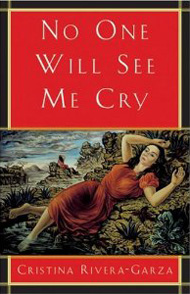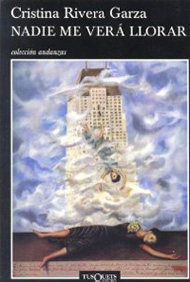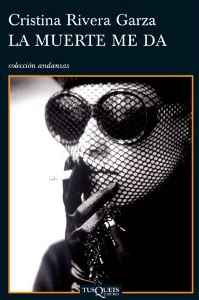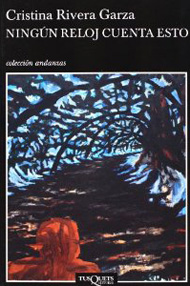

Cristina Rivera-Garza
Cristina Rivera-Garza, award-winning author and Professor of Writing at the University of California, San Diego, is a writer of many talents. Her bibliography includes several novels, poetry, academic articles, and a weekly newspaper column. Born in the city of Matamoros near the Mexican-US border, Ms. Rivera-Garza holds degrees from the National Autonomous University of Mexico and the University of Houston. Her academic interests focus on the history of Mexican psychiatry and the social construction of mental illness. No One Will See Me Cry is her first novel to be translated into English.
Belletrista's Caitlin Fehir spoke with Ms. Rivera-Garza recently on her writing, the status of Latin American literature by women, and what new projects the future holds. It is with great pleasure that Belletrista introduces Cristina Rivera-Garza to our readers.
CF: I recently read your prize-winning novel, No One Will See Me Cry, which incorporates your academic research on the history of Mexican psychiatry. Do you often find your academic interests influencing the literary side of your career?
CRG: The writing and reading of history goes well beyond an academic interest for me. I do have training as a historian, holding a PhD from the University of Houston. I appreciate history as writing. Creative writing, that is. There are two moments that link, in my mind, history and literature together: the moment in which the researcher enters the archive with only a vague idea of what she is looking for, full of anticipation; and the moment in which the reading of the found document, the document the researcher did not necessarily know she was looking for, signals an appropriation. Which could be both subversion and betrayal. Both moments are moments of our rubbing with language.
CF: Joaquín and Matilda, the two protagonists of No One Will See Me Cry, are very damaged people, and the book is quite dark in tone. What was your inspiration for these complex characters?
CRG: She comes directly out of a medical file I found at the archive of the General Insane Asylum—her picture, in which she could not hide a smile, fascinated me from the very beginning. It was a gesture I could not accommodate easily in my notion of insanity or mental institutions or even history at large. A novel is at times just that: a place for a gesture that seems to be out of place.
Joaquín emerged out of the initials an anonymous photographer wrote at the bottom of some porn portraits taken during the early twentieth century in Mexico City. How does someone become a photographer of the mad?—that question, not the most optimistic of all, defined his character.
CF: Congratulations on being awarded the Sor Juana Inés de la Cruz Prize for the second time. I know that one aspect of the prize is the translation into English of the winning novel. When can we expect a translated edition of La muerte me da?
CRG: Much to my dismay, this edition of the award does not include, like previous ones did, the translation into English.
CF: I am always interested is an author's creative process - writing a novel seems like such a daunting task, and I would not even know where to start. Are you a planner, or do you just write and see where it takes you?
CRG: I am usually writing two or three or even more texts at a time, not really knowing which one will become a finished text and which one will not. What is interesting to me in the process of writing is precisely the opportunity to enter a universe I might be able to visualize but that will only know, if at all, through the writing of it. There are questions at the beginning, of course, ideas, readings, some body of knowledge—the challenge in any case is to empty all those, to empty words so that the reader and yourself as reader are now able to dive into them as in a swimming pool—empty. The books I keep with me, the readings I keep remembering are the ones who moved me in that way: a clash, a wake-up-call, a no-way-back.
CF: What styles of writing inspire you? Do you have favourite authors, or works that motivated you to become a writer?
CRG: Many. Avid reader, I am. From Mexico: Juan Rulfo, my undying love to him and his two very slim, very broken, very illuminating books; Amparo Dávila, an obscure writer of horror, semi-gothic stories right from the last quarter of the twentieth century; Jorge Ibarguengoitia, whose books prove that Mexicans do know humor. From US: David Markson, Wittgenstein's Mistress. From Canada: Anne Michaels, her Fugitive Pieces, ah!; Anne Carson, of course, just read her Nox and I am still thinking about it; Michael Ondaatje, whose The Collected Works of Billy the Kid I just assigned in a poetry class. Marguerites: Atwood, Duras, Yourcenar.
CF: Issue 5 of Belletrista focuses on Latin American literature. What authors might you recommend to readers who are looking to explore Latin American literature written by women?
CRG: While usually neglected in literary publications and Latin American presses in general, there is much being done in this regard. Luisa Valenzuela and Diamela Eltit continue to be a must. Poetry-wise: Alejandra Pizarnik, Olga Orozco, Marosa di Giorgio. Risky (as in life vs. death), adventurous, finest intelligence. In México, in addition to Dávila, whose name I mentioned earlier, you would have to read Josefina Vicens, Guadalupe Dueñas, Inés Arredondo—unfortunately translations of their works into English are hard to find, if they exist at all. In my generation: Mayra Santos-Febres from Puerto Rico, for example.
CF: When someone talks about Latin American literature, the names that come up are generally male. Why do you think this is? Is there a current trend towards female writers who might counter a more masculine tradition?
CRG: Just as North American women writers included in the book Feminaissance state, there is much still to be done in terms of balancing the access to publication, and more. In a very interesting article called "Number Trouble", poet Juliana Spahr documents the numbers of women poets NOT included in major anthologies published in the last half of the twentieth century. You might have thought that things had changed, but numbers keep on proving otherwise. There are more and more women writers publishing indeed, and their work covers an ample range of aesthetic explorations, but this does not mean and has not meant that much critical or meaningful attention has been paid to them.
CF: Belletrista works to promote international literature written by women. What is your perspective, as an author writing in both Spanish and English, on the status of female authors, particularly those who write in a language other than English?
CRG: I in fact write mostly in Spanish—although I do some academic writing in English. When I went back to Mexico for a while—I remained there for over five years—I started to write in English: I missed the language, I missed my second-languageness, to be more precise; that awkward way of looking at things. Now that I am back in the border area in between San Diego and Tijuana I went back to Spanish: I missed the language, I missed my second-languagness, to be more precise. Both Spanish and English are now the second one.
CF: Lastly, of course I am curious about your future writing—any projects currently in development?
CRG: I am revising my history book—the one I should have published 15 years ago right out of
graduate school and did not because I published a novel. I think I just began another novel—one
that includes paintings and interventions and collages, but will not know that for sure until later, in
a couple of months, perhaps. A book of poetry is in press—or so it seems. And I am uncovering the
Oulipo-like rules of twitter (@criveragarza).
Interested readers can follow Ms. Rivera-Garza via her blog, "No Hay Tal Lugar": http://cristinariveragarza.blogspot.com, or on twitter (@criveragarza) - both in Spanish.

Caitlin Fehir is an English teacher living in southern Ontario, Canada.
Her reading tastes change daily, and she is constantly adding to her never-ending list of books
to explore. Her new-found love is traveling, an expensive hobby that is supplemented by seeing
the world through literature.




Read Caitlin Fehir's review of Cristina Rivera-Garza's No One Will See Me Cry here.
